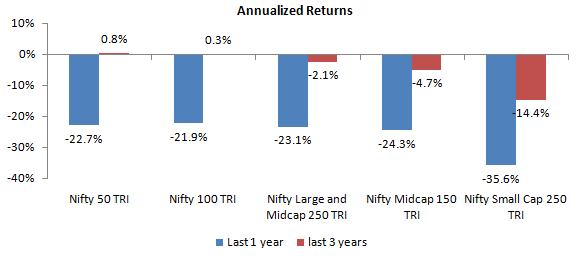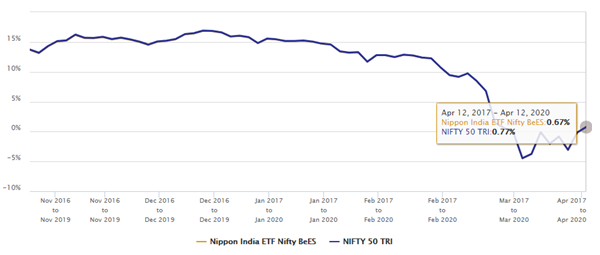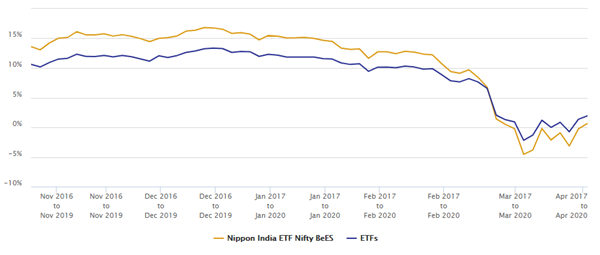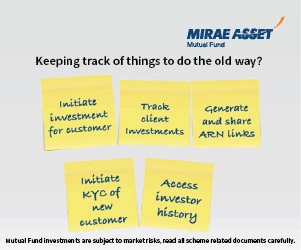Nippon India ETF Nifty BeES: A good long term investment in current market

Exchange traded funds (ETFs) are increasingly becoming popular among investors around the world and also here in India. ETFs invest in the basket of securities that replicates the composition of a market index like Sensex, Nifty, BSE – 100, Nifty – 100 etc. ETFs do not aim to beat market returns, their objective is to track and deliver market returns by tracking the benchmark index’s performance as closely as possible. The biggest advantage of ETFs is low costs.
How to select ETFs?
There are three important parameters which investors should look at when investing in ETFs:-
- Total Expense Ratio: Lower the expense ratio, higher the return for the same underlying assets.
- Tracking error: Tracking error is the deviation between index return and the ETF return. This is an important performance parameter because you are essentially investing in the index.
- Liquidity: This is extremely important because unlike mutual funds, ETFs are bought and sold in the stock exchanges.
Nippon India ETF Nifty BeES
Nippon India ETF Nifty BeES scores highly on all the three above parameters making it one of the best Nifty ETFs. The ETF was launched in December 2001 and has Rs 2,850 Crores of Assets under Management (AUM). The expense ratio of this ETF is just 0.05% (as on 31st March 2020). As the ETF name suggests, the benchmark index of this ETF is Nifty 50 TRI. Vishal Jain is the fund manager of this ETF. The fund manager does not aim to beat Nifty but track Nifty performance.
Why invest in Nifty ETFs?
Sensex and Nifty are the two most popular stock indices in India. They represent the largest 30 and 50 stocks by market capitalization respectively. Sensex and Nifty reflect market sentiments more accurately than any other index. The Nifty – 50 accounts for nearly 67% of the total free float of all stocks traded in National Stock Exchange (NSE).
While Sensex is older and more popular among the general public, Nifty is more popular with professional traders, fund managers, institutional investors and financial advisors for two reasons - Nifty has a much larger derivative (futures and options) market compared to the Sensex. This makes Nifty ETFs much more liquid than Sensex ETFs because it can be used by traders, fund managers and institutional investors for arbitrage, hedging etc. Secondly, Nifty comprising of 50 stocks is more diversified compared to the Sensex (30 stocks).
Nifty outperformed other indices over last 1 – 3 years

Source: Advisorkhoj Research
Nippon India ETF Nifty BeES versus Nifty 50 TRI
The table below shows the trailing returns of Nippon India ETF Nifty BeES versus its benchmark index Nifty 50 TRI over the last 1 year, 3 years and 5 years (periods ending 16th April 2020). You can see that the difference between the ETF and Nifty 50 TRI returns is only 10 to 20 bps. Therefore, the tracking error is quite small.

Source: Advisorkhoj Research
The chart below shows the 3 year rolling returns of Nippon India ETF Nifty BeES versus its benchmark index Nifty 50 TRI over the last 5 years. The orange line representing Nippon India ETF Nifty BeES rolling returns is not visible because it is tracking benchmark very closely across different market conditions.

Source: Advisorkhoj Research
Nippon India ETF Nifty BeES versus other ETFs
The chart below shows the 3 year rolling returns of Nippon India ETF Nifty BeES versus its average rolling returns of other ETFs (including Gold ETFs) over the last 5 years. You can see that Nippon India ETF Nifty BeES consistently outperformed over most periods. The recent relative underperformance of the ETF can be attributed to outperformance of Gold ETFs over the last 1 year or so. We think that the short term underperformance of Nifty versus Gold is temporary because historical data shows that Nifty has outperformed Gold in the long term.

Nippon India ETF Nifty BeES versus other Nifty ETFs costs
Nippon India ETF Nifty BeES is thelowest cost Nifty 50 ETF with an expense ratio of just 0.05%. Average expense ratio of Nifty 50 ETFs is 0.16%. Since all Nifty ETFs aim to track Nifty 50 TRI i.e. the same performance, lower expense ratio directly translates into higher returns.
Nippon India ETF Nifty BeES Liquidity
Investors often ignore liquidity aspect when investing in mutual funds. However, in ETFs liquidity is very important because unlike mutual funds, you cannot redeem ETFs by sending a request to AMCs unless you are redeeming very large volumes which most retail investors will be unable to do.
Most retail investors will have to get liquidity for ETFs in the stock exchanges. If you do not find enough buyers in the stock exchange you may not be able to sell your ETF units. To get a sense of liquidity of ETFs you have to look at traded volumes of shares / units in the exchange. Over the last 10 days on an average, 3.8 million units of Nippon India ETF Nifty BeES were traded daily in National Stock Exchange (source: NSE) making this one of the most liquid Nifty ETFs.
Conclusion
In this blog post, we reviewed Nippon India ETF Nifty BeES. We discussed several performance and other features which makes it one of the best Nifty ETFs. Nifty ETFs are one of the best long term investments in the current market conditions. Nifty companies will be less affected by the slowdown / contraction in economic activities caused by the lockdown compared to smaller companies. Like in the past, recovery from the market downturn will most likely be led by Nifty companies. You should consult with your financial advisors if Nippon India ETF Nifty BeES is suitable for your investment needs.
Mutual Fund Investments are subject to market risk, read all scheme related documents carefully.
Queries
-
What is the benefit of mutual fund STP
Aug 29, 2019
-
How much to invest to meet target amount of Rs 2 Crores
Aug 26, 2019
-
Can I achieve my financial goals with my current mutual fund investments
Aug 24, 2019
-
Can you tell me return of various indices
Aug 19, 2019
-
What would be the post tax return on different investments
Aug 18, 2019
-
Which Principal Mutual Fund scheme will be suitable for my retirement corpus
Aug 16, 2019
-
What is the minimum holding period for availing NCD interest
Aug 4, 2019
Top Performing Mutual Funds
Recommended Reading
Fund News
-
Bandhan Mutual Fund launches Bandhan Silver ETF FOF
Jan 12, 2026 by Advisorkhoj Team
-
Bandhan Mutual Fund launches Bandhan Gold ETF FOF
Jan 12, 2026 by Advisorkhoj Team
-
The Wealth Company Mutual Fund launches The Wealth Company Gold ETF FOF
Jan 9, 2026 by Advisorkhoj Team
-
Mahindra Manulife Mutual Fund launches Mahindra Manulife Innovation Opportunities Fund
Jan 9, 2026 by Advisorkhoj Team
-
Jio BlackRock Mutual Fund launches Jio BlackRock Short Duration Fund
Jan 8, 2026 by Advisorkhoj Team














